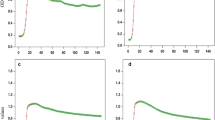Abstract
The optimisation of submerged culture conditions and nutritional requirements was studied for the production of exopolysaccharide (EPS) fromPleurotus nebrodensis. The optimal temperature and initial pH for both mycelial growth and EPS production in shake flask cultures were 25 °C and 8.0, respectively. Maltose was found the most suitable carbon source for both mycelial biomass and EPS production. Yeast extract was favourable nitrogen source for both mycelial biomass and EPS production. Optimum concentration of each medium component was determined using the orthogonal matrix method. The optimal combination of the media constituents for mycelial growth and EPS production was as follows: 200 g l−1 bran, 25 g l−1 maltose, 3 g l−1 yeast extract, 1 g l−1 KH2PO4, 1 g l−1 MgSO4 7H2O. Under the optimal conditions, the mycelial biomass (4.13 g l−1) and EPS content (2.40 g l−1) ofPleurotus nebrodensis was 2.3 and 3.6 times compared to the control with basal medium respectively.
Similar content being viewed by others
References
Chaplin M.F., Kennedy J.F. (1994). Carbohydrate Analysis, A Practical Approach, 2nd edn., IRL Press Ltd, USA.
Chen Z.C. (1986). The experiment on cultivation ofPleurotus ferulae. Edible Fungi, 2: 10–11.
Deng C.S., Lv Z.Z. (2002). Study on immunological activities of water soluble polysaccharides fromPleurotus ferulae Lanzi. Journal of Huazhong Agricultural University, 21: 447–449.
Deng B.W., Chen W.Q. (2005). Studies on optimal conditions of producing exopolysaccharide fromBoletus edulis [J]. Food and Fermentation Industries, 31: 60–63.
Dong H.X., Liu J.J., Wang K. (2004a). Initial studies on the fermentation conditions ofPleurotus ferulae. Biotechnology Bulletin, 5: 48–51.
Dong H.X., Liu X.H., Xu Z.L., Cai D.H. (2004b). A study on the extraction technology of polysaccharide fromPleurotus nebrodensis fruiting body. Acta Edulis Fungi, 11: 22–25.
Dong H.X., Ren G.T., Huang Q.R., Wang S.F. (2004c). Study on submerged culture technology ofPleurotus ferulae. Journal of Microbiology, 24: 22–24.
Gan Y., Lv Z.Z. (2001). Studies on physical and chemical properties and immunological activities of polysaccharides fromPleurotus ferulae. Mycosystema, 20: 228–232.
Jiang Y.H., Jiang X.L., Wang P., Wang S.Y. (2005). A study on submerged fermentation conditions ofPleurotus nebrodensis and the cultivation. Acta Edulis Fungi, 12: 37–41.
Li Y.Q., Wu J., Yang Q.Z., Qin W.P., Shen D.H., Wu Y.W. (2003). Study on submerged fermentation technology ofPleurotus nebrodensis. Journal of Northwest University for Nationalities (Natural Science), 24: 14–18.
Li Z.P., Cai Y.P., Lin Y., Li T.C., Fan H.H. (2005). The extraction of polysaccharide from submerged fermentation ofPleurotus ferulae. Packaging and Food Machinery, 23: 28–30.
Lin J. 2000. The key technology for cultivation ofPleurotus ferulae. Edible Fungi of China, 19: 28–29.
Rosado F.R., Germano S., Carbonero E.R., Da Costa S.M., Iacomini M., Kemmelmeier C. (2003). Biomass and exopolysaccharide production in submerged cultures ofPleurotus ostreatoroseus Sing, andPleurotus ostreatus “florida” (Jack.: Fr.) Kummer [J]. Journal of Basic Microbiology, 43: 230–237.
Wang X.F., Wang Y.L., Liang J.G. (2005). Study on optimization of media forGenoderma lucidum polysaccharide and its fermentation [J]. Amino Acid and Biotic Resources, 27: 23–26.
Yang L.H., Lin J., Huang Q.R., Cai D.H., Lang X.C. (2004). Optimization of polysaccharide extraction from mycelia ofPleurotus ferulae Lanzi prepared by liquid submerged fermentation. Industrial Microbiology, 3: 28–31.
Yang M., Chen L.H., Shi L., Wang L.Y. (2006). A study on submerged culture technology ofPleurotus ferulae and the analysis of the composition. Journal of Fujian Normal University (Natural Science Edition), 22: 77–81.
Zhang J.H., Zhao J.Z., Hao Z.B. (2002). Submerged culture of edible and medicinal fungi. Forestry Science and Technology, 27: 61–63.
Zheng L., Huang Y.C., Gao Q.X., Pu X., Li S.F., Bi Y.R. (2005). Antioxidative and antitumor activities of the crude extracts ofPleurotus eryngii var.nebrodensis. Mycosystema, 24: 71–78.
Author information
Authors and Affiliations
Corresponding author
Rights and permissions
About this article
Cite this article
Le, J., Hu, S. & Xu, M. Optimisation of submerged culture conditions for the production of mycelial biomass and exopolysaccharide byPleurotus nebrodensis . Ann. Microbiol. 57, 389–393 (2007). https://doi.org/10.1007/BF03175078
Received:
Accepted:
Issue Date:
DOI: https://doi.org/10.1007/BF03175078




